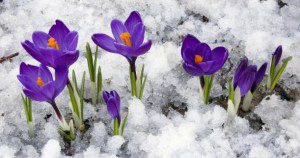By Abigail Turner
Guest Writer for Wake Up World
Winter, with its freezing cold temperatures and cutting winds, can be a tough time for gardeners and their plants. Buds and blossoms can wither and die, and often those plants that make it through hard freezes will still end up with unsightly brown spots. Even evergreens can have difficulty if you don’t know what you’re doing.
Here are 10 helpful tips to get you – and your garden – through the cold.
1. Before the ground freezes, make sure that you water your plants. It will be much easier for them to drink when the earth still has some give. This is especially important for evergreens.
2. Use frost cover or an old sheet to cover plants with buds or open flowers. Generally, this will be plenty to keep the blossoms protected from the freeze and they won’t become damaged or fall off. Just be careful not to use plastic, because when the sun comes out, it can make your plants bake like they’re in an oven.
[pro_ad_display_adzone id=”110028″]
3. Protect your pots, too. It’s not just your plants that you need to worry about – some pots can shatter in freezing temperatures unless you give them protection. One of the best things to use is burlap. Wrap it around the pot and then use garden string to hold it on.
4. Keep the temperatures of your plants’ roots stable to avoid damage from rapid heating and cooling. How? By using winter mulch around them – it’s especially helpful for roses and perennials.
5. Group plants together. This will help you to limit damage caused by strong winds since the plants will slow the gusts down. Also, keeping them close provides added insulation from the cold.
6. Continue to prune. Just because your trees and shrubs don’t have any leaves doesn’t mean that you should stop. You want to prune so that you can get rid of dead branches, waterspouts, and branches that cross. They may not seem problematic now, but they will be once the leaves start to grow in again.
7. Use bubble wrap for potted plants. Unlike plants that are rooted in the ground, the roots of potted plants have less than an inch separating them from the freezing air. To give your potted plants some extra insulation, try lining the pot with bubble wrap before you add the plant and the soil. For clay pots, this also helps to keep moisture from evaporating.
8. Don’t fertilize. Winter should be a time for your garden plants to rest and, for lack of a better term, hibernate. They shouldn’t be starting new growth until spring, when the ground warms up. If you try to force this by using fertilizer on them, any new growth that occurs is likely to be killed off by hard frosts, ice storms, and even just the cold temperatures themselves.
9. Prevent winter burn in evergreens with an anti-transparent that can be sprayed onto them. This is particularly important for broadleaf’s.
10. Be prepared to bring less hardy plants inside. Some tender plants just aren’t meant to be outside in the harsh winter, so you have to plan ahead and make sure you have a place for them. It might be a conservatory, a greenhouse, or even just a room in your house that stays fairly cool. Wherever you put them, you’ll want to make sure that they get bright, indirect light for at least five hours every day and aren’t near heating vents or drafts. And before you bring them in (especially if you’re taking them into your home), use an insecticidal soap to spray the leaves and a pet- and people-safe insecticidal drench to water them. This should kill off any critters you don’t want in your home.
About the author:
Abigail Turner writes about gardening and landscaping for Architectural Gardens. Abigail enjoys gardening and home cooking when she’s not writing.
[pro_ad_display_adzone id=”110027″]







